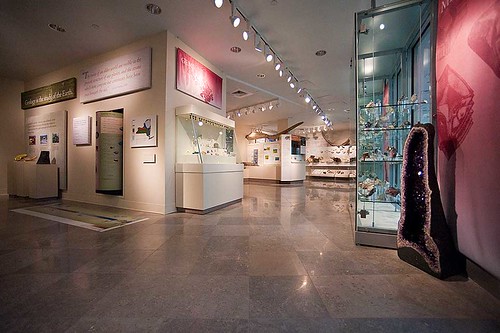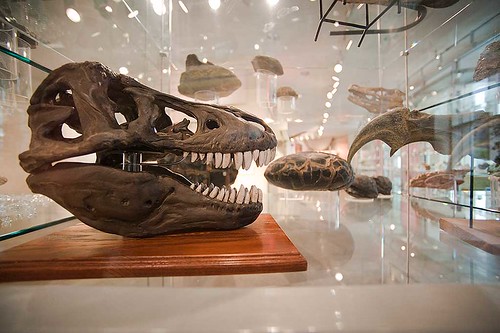With displays of precious gems, a wall of skulls, and interactive exhibit of ¸Ô±ľĘÓƵ’s very own dinosaur egg, the Robert M. Linsley Geology Museum educates visitors, while inspiring them with the wonder of its objects.
A large green sign reading “Geology is the study of the Earth” welcomes visitors when they first enter the museum, which recently moved from Lathrop Hall to its new home in the Robert H.N. Ho Science Center.
Di Keller ’81, senior lecturer in geology and chair of the museum project, explained that the entrance is intended to educate people about the science of geology.
“We want people to gain an understanding of what we know about the Earth – how it works now, its history, and how this can be applied to understanding what might happen in the future. Also, how do we know what we know?”
In order to help visitors understand geology of the region, there is an underlying focus on New York State.
 |
| The Linsley museum is on the second floor of the Ho Science Center and is open from 9 a.m. to 4 p.m. Monday through Friday. It was formally dedicated on Friday, Oct. 2. (Photo by Andy Daddio) |
Displays include local bedrock with parallel grooves carved on the top that indicate that glacial ice covered this area 22,500 years ago. A mastodon tooth found during a pond excavation behind Hamilton Central School alludes to the region’s inhabitants during that time.
One of the most interesting features of the museum is the 80-million-year-old dinosaur egg donated to the university in 1924 by university trustee Col. Austen B. ¸Ô±ľĘÓƵ.
Geology professor Connie Soja researched and told the story of this specimen, one of the first dinosaur eggs ever discovered.
It is currently on public display – protected by a high-level security system – for the first time since it was stolen as a prank by two ¸Ô±ľĘÓƵ students in 1957.
Soja was one of many members of the geology department to contribute to the museum project.
“Department discussions began about three years ago to decide on major themes, the overall layout, write text, and brainstorm about display designs and special features,” said Keller.
The museum is named after Robert M. Linsley, who taught at ¸Ô±ľĘÓƵ from 1955 to 1992, specializing in courses related to paleontology and evolution. The university raised funds for it through a matching grant gift provided by Sylvia and Malcolm Boyce ’54
“We hope that after visiting, people will carry the same techniques of observation and interpretation with them wherever future travels bring them,” said Keller.
 |
| Skulls of animals that went extinct by the end of the Ice Ages as well as skulls of related species that survived and are still living today are part of the Linsley collection. (Photo by Andy Daddio) |